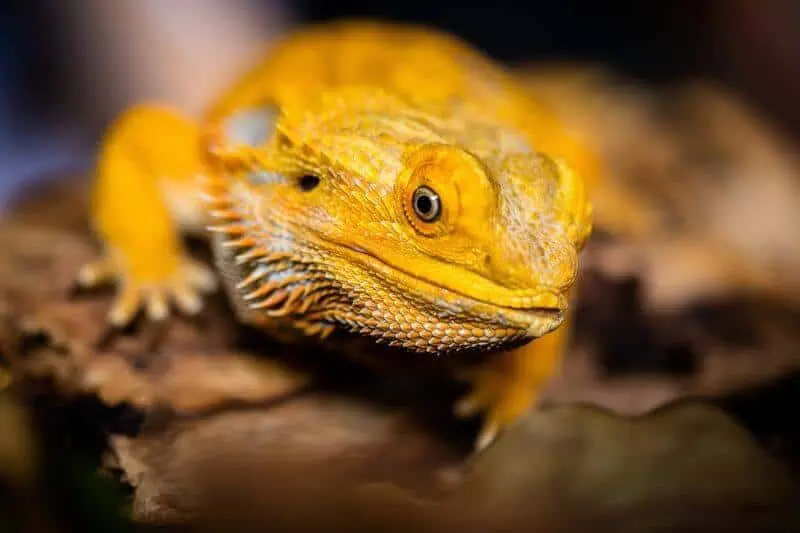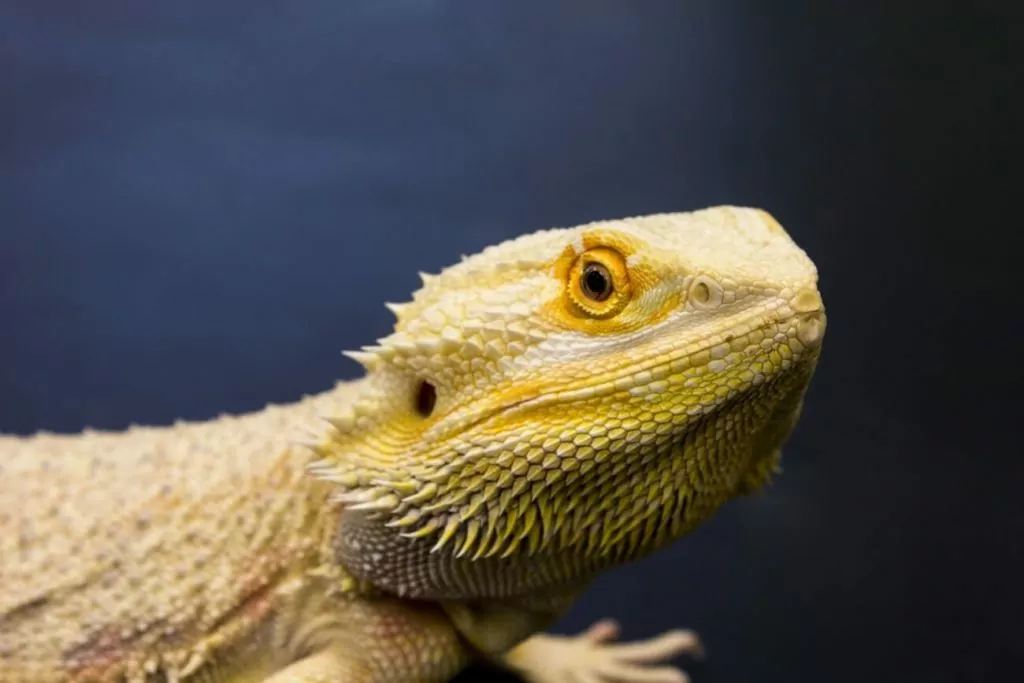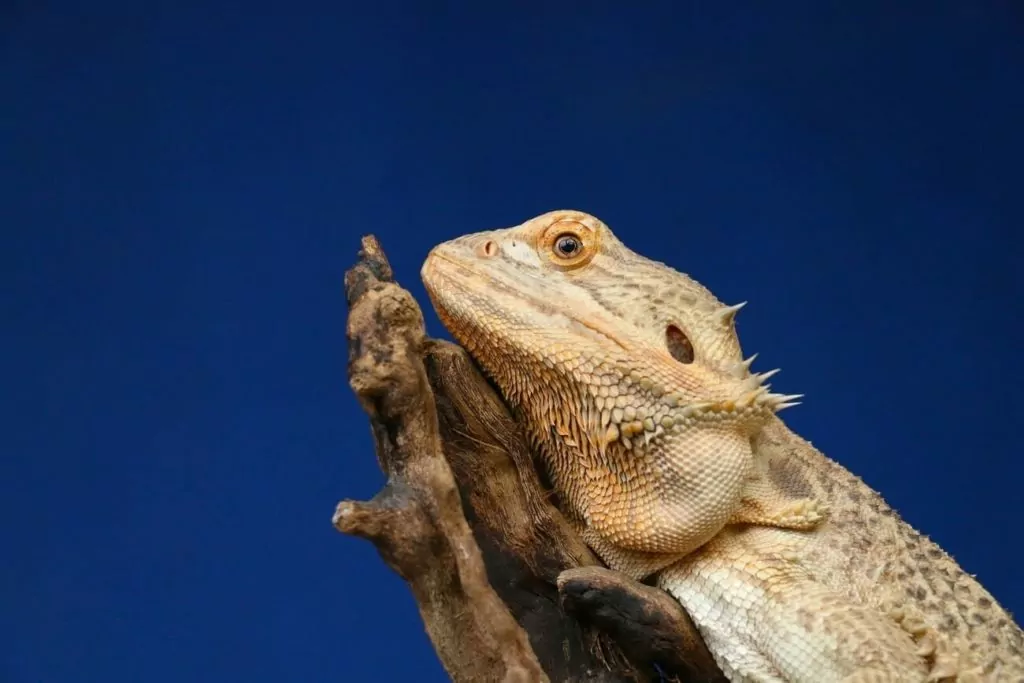Learning how to tell if your bearded dragon is happy is an important skill if you want your pet to thrive. Unlike other more popular pets like cats and dogs, determining the mood of a lizard requires a bit of nuance.
Let’s go over the signs of a happy bearded dragon, and what you can do to keep them that way.
1. Active And Healthy Behavior
One of the best ways to tell if your bearded dragon is happy is to pay attention to its behavior.
In the wild, these creatures spend their days exploring. They climb surfaces, investigate every inch of their environment, and dig below the surface. They’re fairly active animals during the day between basking sessions.
Consider it a good thing if you see your beardie living an active and healthy lifestyle! It means that they have no reason to hide and don’t have any health issues preventing them from living life to the fullest.
On the contrary, an unhappy bearded dragon will usually spend most of its day in hiding. These animals prefer to seek refuge under shelter when they’re stressed or anxious. Even seeing your lizard out in the open means they’re comfortable enough to roam the habitat and explore to their heart’s content.
Encourage exploration and play by adding more enrichment items. In addition to a basic hide shelter, consider installing new decorative features. Things like tunnels, climbing rocks, and diggable substrate material can make all the difference. Even having a bowl of water to investigate goes a long way.
Keep your beardie active, and they can stay happy for years to come.
Don’t forget to pay attention to routine health factors, too. Make sure that your bearded dragon has a healthy appetite and is doing their business regularly. Check off those boxes, and you have yourself a happy beardie.
2. You See Them Basking Regularly
When a happy bearded dragon isn’t roaming around and finding things to explore, it will likely be basking and relaxing.
Basking is one of these pet lizards‘ favorite hobbies, and it plays an important part in their overall health. Sitting under the warm glow of a basking lamp helps with thermoregulation. The extra time under UVB lamps also enables your reptile to soak up that valuable Vitamin D for calcium absorption.
It should be a red flag if you rarely see your bearded dragon basking throughout the day. The absence of that behavior is abnormal for these reptiles and could indicate potential health problems, discomfort, or general unhappiness.
3. You Can Pick Them Up Easily
Another good sign that your bearded dragon is happy is if they’re relatively easy to pick up.
Some misconceptions exist about how these reptiles behave with human contact. Contrary to popular belief, stone-like stillness isn’t necessarily a good sign. Bearded dragons can react in many ways when you pick them up based on their feelings.
In most cases, your lizard will make it known if they don’t want human contact. They’ll flee when you place your hand in the tank, show signs of aggression, and wriggle out from beneath your hand whenever you get near. Those are all obvious signs that they don’t want to be picked up or pet.
If those reactions occur frequently, you may need to work on socializing your beardie in order to make them happier. It’s normal for these lizards to resist pickups every once in a while, but it’s not normal for them to run away from you every time.
Beyond those apparent signs of distress, bearded dragons exhibit more subtle body language. In some instances, your lizard may grow stiff or let their body flop down while you try to lift them. They may also close their eyes and not move.
You might assume that those signs indicate that your bearded dragon is fine with you picking them up, but it’s quite the contrary. Stiff body language and closed eyes mean your lizard is fearful and bracing for a potential injury!
Not every beardie will be bold with their dissatisfaction, so you must learn to read your lizard’s body language.
You’ll know that your reptile is happy and fine with being picked up because it won’t resist. It might come to you once you stick your hand in the habitat and show general relaxation as you touch its skin. Receptive behavior makes it far easier to pick a bearded dragon up than one clenched with fear.
4. Consistent Handling Is Well-Received
Receiving a warm reception to handling is a good indicator of your bearded dragon’s happiness. It proves that they trust you and have nothing to fear.
Now, no bearded dragon will be willing to tolerate excessive handling all the time. They have their limits! This is especially true when they’re shedding.
Don’t be surprised if your lizard resists your touch every once in a while. But if it consistently responds well to handling, you’ve done your job. Continue to build trust with your bearded dragon to keep them happy.
5. Open Eyes
A bearded dragon’s eyes can tell you a lot about what they’re feeling. Unfortunately, many people get the wrong idea about common behaviors.
Contrary to popular belief, closed eyes do not correlate to relaxation or contentment. For bearded dragons, it’s the opposite.
If your lizard closes its eyes when you touch it and attempt to handle it, you’re doing something wrong. Closed eyes indicate that the lizard is fearful. It goes back to that “bracing for impact” response of these reptiles when they get scared.
They’re not falling asleep or taking in the moment. Those closed eyes mean that your lizard is scared for its life!
If you notice your bearded dragon closing its eyes for extended periods, give it some space. Use the eyes to gauge your beardie’s comfort level and react accordingly. You know that they’re happy when they stay open-eyed and alert with every interaction.
6. No Aggressive Behavior
Aggression in any form is not a good sign.
For the most part, happy bearded dragons are docile creatures. They much prefer to run and hide instead of being the aggressor. But make no mistake: They will make themselves threatening if they feel the need to do so.
Common signs of aggression include hissing, tail-whipping, and open-mouthed stances. You may also see them puff up their bodies or flare their signature beards. When you see that, back off! Otherwise, your bearded dragon might attempt to retaliate.
Aggression is a form of self-preservation. It means that your lizard is stressed and possibly scared. They use aggressive behaviors to look intimidating and encourage you to step away.
Ideally, you should never see that side of your bearded dragon. A lack of aggression is a big plus, indicating that they’re happy and comfortable enough with you to feel safe.
7. They’re Alert
When you’re trying to determine if your bearded dragon is happy or not, pay close attention to how alert they are to the world around them. These reptiles are naturally alert and are always observing their surroundings.
That might seem signs of anxiety, but it actually points to feelings of comfort. Bearded dragons like being in control and alert at all times. It’s only when they can’t see what’s around the corner that they grow fearful.
Your bearded dragon should have active eyes constantly darting around the room. Their pupils should be small, indicating they’re focusing on objects in the distance. When you move, your lizard’s eyes and head should follow.
If you don’t see signs of alertness, it could mean that they’re dealing with stress or potential medical problems.
8. They Don’t Run From You
It’s in a bearded dragon’s nature to run away. In the wild, the reptiles live solitary lives. They don’t rely on a pack to keep them safe. As a result, they tend to live more cautiously than more confident animals with the protection of others.
As mentioned earlier, they’re always alert and looking for potential threats in their surroundings. It’s common for them to be a little cautious when new things enter the environment. That includes your hand!
So what does it mean when they don’t run away?
If your bearded dragon remains calm, that’s a great sign that they’re happy and comfortable. Your lizard doesn’t feel the need to flee when you encroach on its domain. They trust you and don’t believe that you will cause them harm.
That’s a telltale sign of a happy bearded dragon!
9. They Lay Or Sleep On You For A While
Have you ever tried to relax with your bearded dragon while lounging on your bed or sofa? In most cases, these lizards will get angsty after about ten minutes of handling. As we said earlier, they have limits and usually don’t like prolonged human contact.
But sometimes, you reach a level of trust that defies the norm. Many bearded dragon owners develop such a tight bond with their pets that they can hold them longer than average.
One of the most rewarding things you can witness is your bearded dragon comfortably lying on your body and falling asleep. They could get cozy in your arms or plop down on your chest for a good snooze. Either way, those are all fantastic signs of happiness.
Once again, it goes back to trust. Your happy bearded dragon entrusts you with their life and safety. They feel a bond that’s strong enough to let their guard down and relax.
10. They Walk Over To You
If you thought that bearded dragons not fleeing was a sign of their happiness, wait until you get to the point where they start to greet you at their habitat walls!
A happy bearded dragon with a lot of trust in its owner will often walk over to them. They might run up to the glass when you near their enclosure or saunter over to your hand when you’re doing tank maintenance. If they have free roam of a safe room, they may even run to you when you place them on the floor!
That positive body language is downright adorable and a good indicator of your lizard’s happiness. Trust is something that takes time to build. But once you get to this point, it’s smooth sailing for you and your beardie.
11. Their Skin Gets Lighter
Did you know that a bearded dragon’s skin can change colors? We’re not talking about the pale gray that develops during shedding. This reptile can develop a vibrant color based on its mood.
Happy beardies will turn noticeably brighter. They can take on a yellow, orange, or light brown shade that’s significantly more saturated than what you’re used to seeing. It can be alarming at first, but it’s often a positive indicator of happiness.
Color changes can happen for a variety of reasons. It can change based on body temperature, general health, and more. These lizards have chromatophores in their skin that change how it reflects light.
Usually, color changes are a reaction to something in the environment. However, reptile enthusiasts everywhere will tell you that it also happens when these lizards are comfortable and in a great mood.
Conclusion
Now that you know how to tell if your bearded dragon is happy or not, it’s time to start looking for these signs. If you see anything you don’t like, make some changes!
We hope you found this guide helpful. If you have any questions about the information you read above, send us a message.



